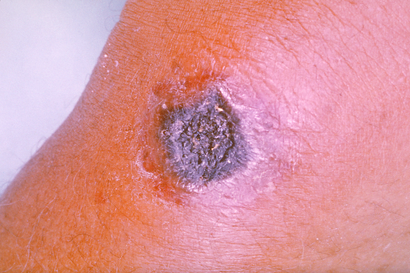Anthrax facts for kids
Quick facts for kids Anthrax |
|
|---|---|
 |
|
| A skin lesion with black eschar characteristic of anthrax | |
| Symptoms | Skin form: small blister with surrounding swelling Inhalational form: fever, chest pain, shortness of breath Intestinal form: nausea, vomiting, diarrhea, abdominal pain Injection form: fever, abscess |
| Usual onset | 1 day to 2 months post contact |
| Causes | Bacillus anthracis |
| Risk factors | Working with animals, travelers, postal workers, military personnel |
| Diagnostic method | Based on antibodies or toxin in the blood, microbial culture |
| Prevention | Anthrax vaccination, antibiotics |
| Treatment | Antibiotics, antitoxin |
| Prognosis | 20–80% die without treatment |
| Frequency | >2,000 cases per year |
Anthrax is an infection caused by the bacterium Bacillus anthracis. Infection typically occurs by contact with the skin, inhalation, or intestinal absorption.
Contents
Etymology
The English name comes from anthrax (ἄνθραξ), the Greek word for coal, possibly having Egyptian etymology, because of the characteristic black skin lesions developed by people with a cutaneous anthrax infection. The central black eschar surrounded by vivid red skin has long been recognised as typical of the disease. The first recorded use of the word "anthrax" in English is in a 1398 translation of Bartholomaeus Anglicus' work De proprietatibus rerum (On the Properties of Things, 1240).
Anthrax was historically known by a wide variety of names indicating its symptoms, location and groups considered most vulnerable to infection. They included Siberian plague, Cumberland disease, charbon, splenic fever, malignant edema, woolsorter's disease and la maladie de Bradford.
Symptoms
Symptom onset occurs between one day and more than two months after the infection is contracted. The skin form presents with a small blister with surrounding swelling that often turns into a painless ulcer with a black center. The inhalation form presents with fever, chest pain and shortness of breath. The intestinal form presents with diarrhea (which may contain blood), abdominal pains, nausea and vomiting.
History of research
According to the Centers for Disease Control and Prevention in the United States, the first clinical descriptions of cutaneous anthrax were given by Maret in 1752 and Fournier in 1769. Before that anthrax had been described only through historical accounts. The Prussian scientist Robert Koch (1843–1910) was the first to identify Bacillus anthracis as the bacterium that causes anthrax.
Spreading
Anthrax is spread by contact with the bacterium's spores, which often appear in infectious animal products. Contact is by breathing or eating or through an area of broken skin. It does not typically spread directly between people. Risk factors include people who work with animals or animal products, and military personnel. Diagnosis can be confirmed by finding antibodies or the toxin in the blood or by culture of a sample from the infected site.
Prevention
Anthrax vaccination is recommended for people at high risk of infection. Immunizing animals against anthrax is recommended in areas where previous infections have occurred. A two-month course of antibiotics such as ciprofloxacin, levofloxacin and doxycycline after exposure can also prevent infection. If infection occurs, treatment is with antibiotics and possibly antitoxin. The type and number of antibiotics used depend on the type of infection. Antitoxin is recommended for those with widespread infection.
Epidemiology
A rare disease, human anthrax is most common in Africa and central and southern Asia. It also occurs more regularly in Southern Europe than elsewhere on the continent and is uncommon in Northern Europe and North America. Globally, at least 2,000 cases occur a year, with about two cases a year in the United States. Skin infections represent more than 95% of cases. Without treatment the risk of death from skin anthrax is 23.7%. For intestinal infection the risk of death is 25 to 75%, while respiratory anthrax has a mortality of 50 to 80%, even with treatment. Until the 20th century anthrax infections killed hundreds of thousands of people and animals each year. In herbivorous animals infection occurs when they eat or breathe in the spores while grazing. Animals may become infected by killing and/or eating infected animals.
As a biological weapon
Anthrax has been developed as a weapon by a number of countries. Anthrax has been used in biowarfare and bioterrorism since 1914. However, in 1975 the Biological Weapons Convention prohibited the "development, production and stockpiling" of biological weapons. It has since been used in bioterrorism. Likely delivery methods of weaponized anthrax include aerial dispersal or dispersal through livestock; notable bioterrorism uses include the 2001 anthrax attacks and an incident in 1993 by the Aum Shinrikyo group in Japan.
Other animals
Anthrax is especially rare in dogs and cats, as is evidenced by a single reported case in the United States in 2001. Anthrax outbreaks occur in some wild animal populations with some regularity.
Russian researchers estimate arctic permafrost contains around 1.5 million anthrax-infected reindeer carcasses, and the spores may survive in the permafrost for 105 years. A risk exists that global warming in the Arctic can thaw the permafrost, releasing anthrax spores in the carcasses. In 2016, an anthrax outbreak in reindeer was linked to a 75-year-old carcass that defrosted during a heat wave.
See also
 In Spanish: Carbunco para niños
In Spanish: Carbunco para niños

